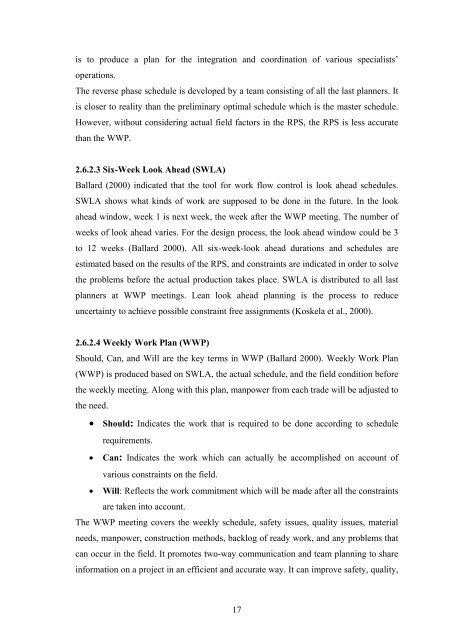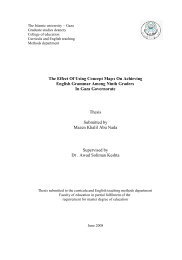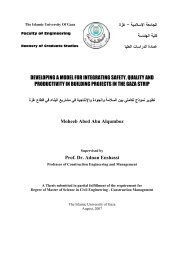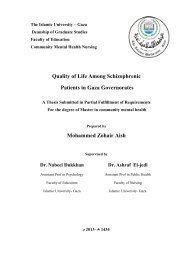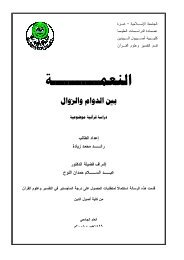A Study of Lean Construction Practices in Gaza Strip
A Study of Lean Construction Practices in Gaza Strip
A Study of Lean Construction Practices in Gaza Strip
You also want an ePaper? Increase the reach of your titles
YUMPU automatically turns print PDFs into web optimized ePapers that Google loves.
is to produce a plan for the <strong>in</strong>tegration and coord<strong>in</strong>ation <strong>of</strong> various specialists’<br />
operations.<br />
The reverse phase schedule is developed by a team consist<strong>in</strong>g <strong>of</strong> all the last planners. It<br />
is closer to reality than the prelim<strong>in</strong>ary optimal schedule which is the master schedule.<br />
However, without consider<strong>in</strong>g actual field factors <strong>in</strong> the RPS, the RPS is less accurate<br />
than the WWP.<br />
2.6.2.3 Six-Week Look Ahead (SWLA)<br />
Ballard (2000) <strong>in</strong>dicated that the tool for work flow control is look ahead schedules.<br />
SWLA shows what k<strong>in</strong>ds <strong>of</strong> work are supposed to be done <strong>in</strong> the future. In the look<br />
ahead w<strong>in</strong>dow, week 1 is next week, the week after the WWP meet<strong>in</strong>g. The number <strong>of</strong><br />
weeks <strong>of</strong> look ahead varies. For the design process, the look ahead w<strong>in</strong>dow could be 3<br />
to 12 weeks (Ballard 2000). All six-week-look ahead durations and schedules are<br />
estimated based on the results <strong>of</strong> the RPS, and constra<strong>in</strong>ts are <strong>in</strong>dicated <strong>in</strong> order to solve<br />
the problems before the actual production takes place. SWLA is distributed to all last<br />
planners at WWP meet<strong>in</strong>gs. <strong>Lean</strong> look ahead plann<strong>in</strong>g is the process to reduce<br />
uncerta<strong>in</strong>ty to achieve possible constra<strong>in</strong>t free assignments (Koskela et al., 2000).<br />
2.6.2.4 Weekly Work Plan (WWP)<br />
Should, Can, and Will are the key terms <strong>in</strong> WWP (Ballard 2000). Weekly Work Plan<br />
(WWP) is produced based on SWLA, the actual schedule, and the field condition before<br />
the weekly meet<strong>in</strong>g. Along with this plan, manpower from each trade will be adjusted to<br />
the need.<br />
• Should: Indicates the work that is required to be done accord<strong>in</strong>g to schedule<br />
requirements.<br />
• Can: Indicates the work which can actually be accomplished on account <strong>of</strong><br />
various constra<strong>in</strong>ts on the field.<br />
• Will: Reflects the work commitment which will be made after all the constra<strong>in</strong>ts<br />
are taken <strong>in</strong>to account.<br />
The WWP meet<strong>in</strong>g covers the weekly schedule, safety issues, quality issues, material<br />
needs, manpower, construction methods, backlog <strong>of</strong> ready work, and any problems that<br />
can occur <strong>in</strong> the field. It promotes two-way communication and team plann<strong>in</strong>g to share<br />
<strong>in</strong>formation on a project <strong>in</strong> an efficient and accurate way. It can improve safety, quality,<br />
17


